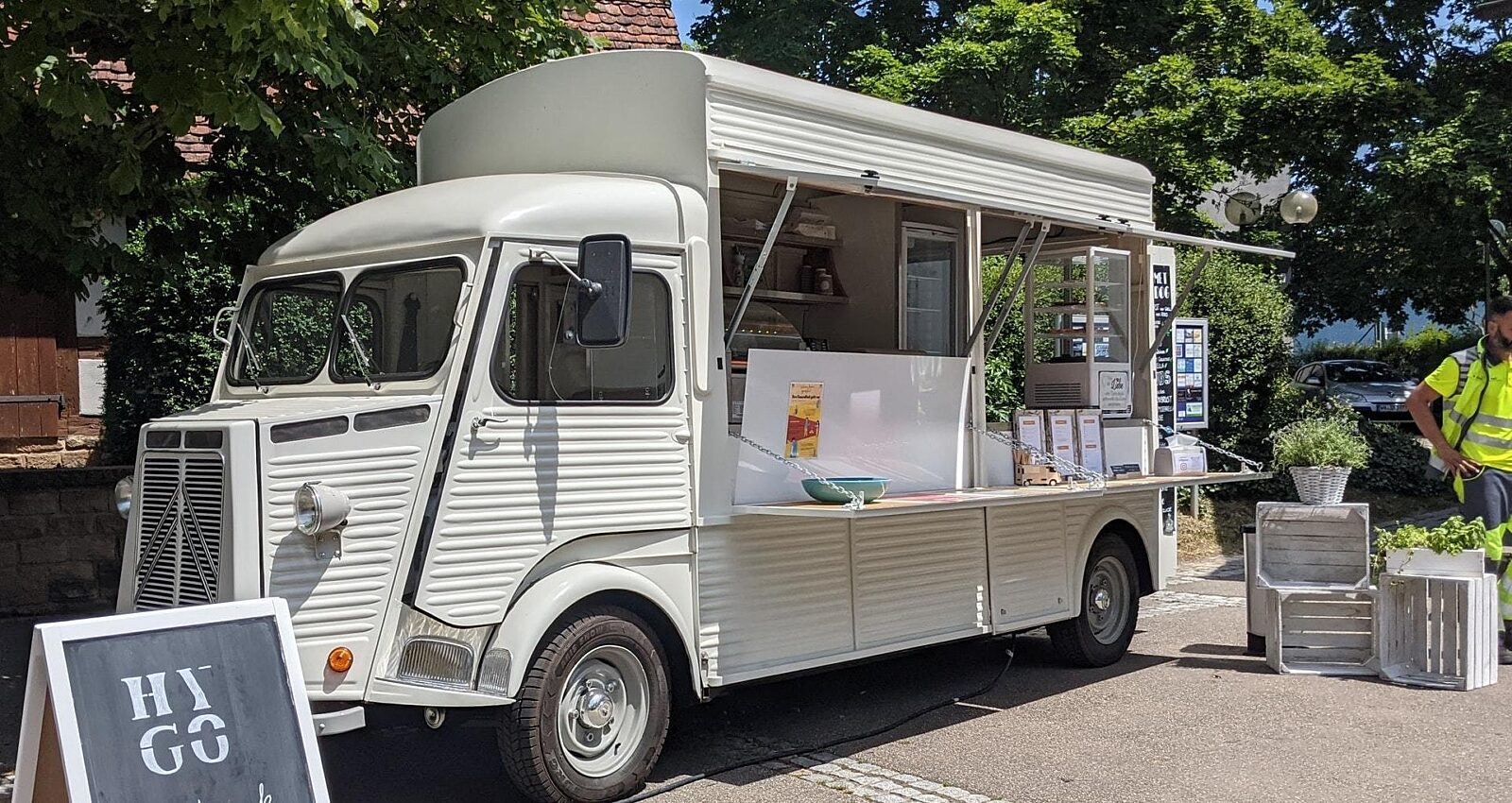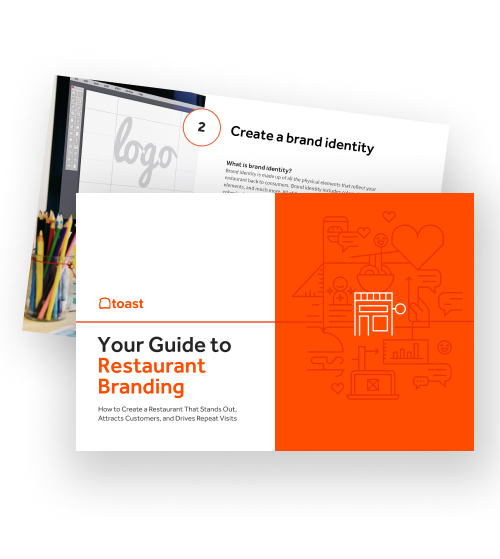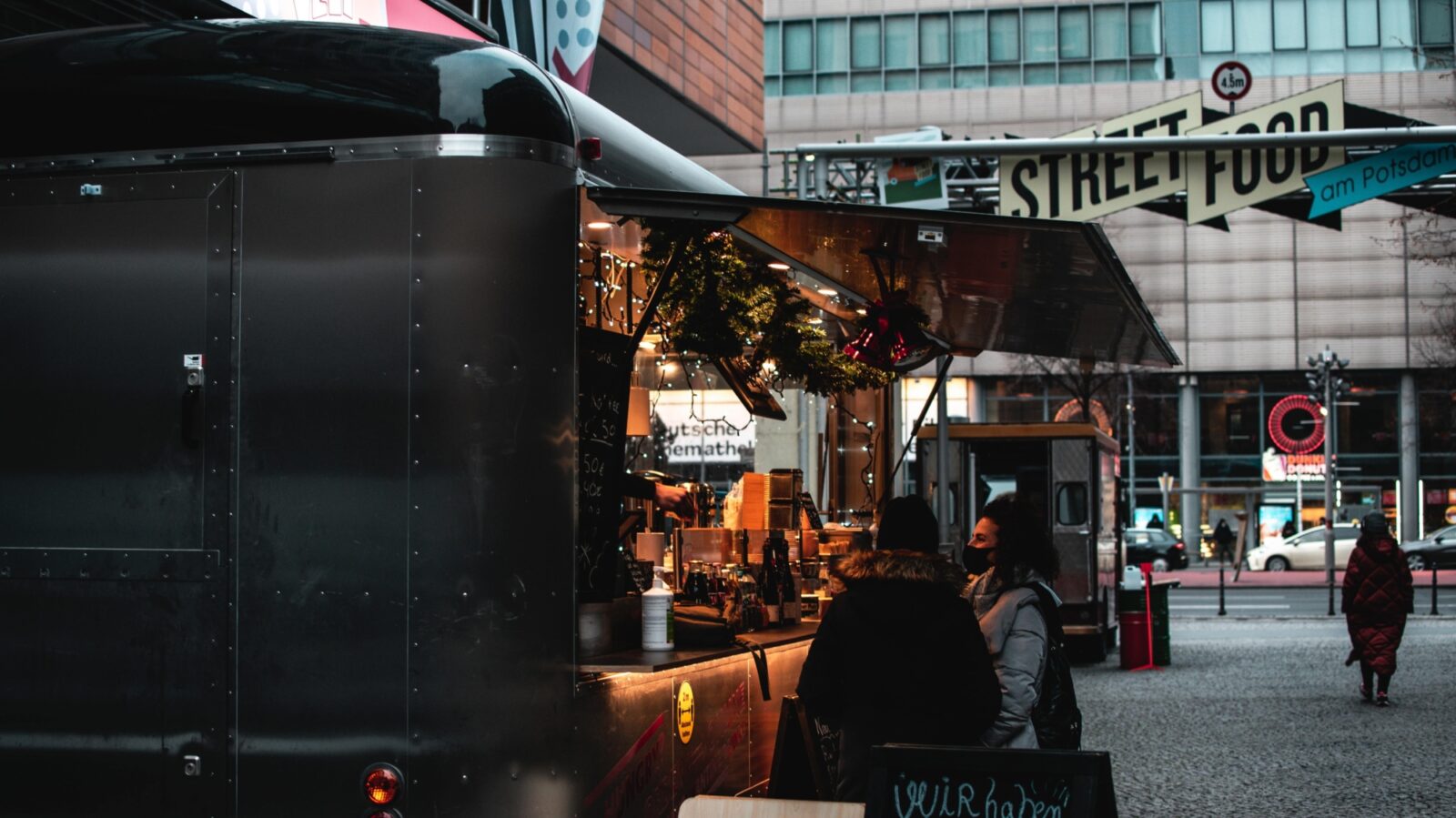
How to Design a Food Truck: 20 Food Truck Design Ideas
20 food truck design ideas that will help catch your customers’ attention.

Tessa ZuluagaAuthor


The Ultimate Guide to Restaurant Branding
Use this guide to get tips on how to create a restaurant brand that stands out, attracts customers, and drives repeat visits.
Get free downloadThere are 35,512 Food Trucks businesses in the US as of 2022, an increase of 13.7% from 2021. To help compete with the other 35,511 trucks, mold an eye-catching restaurant design that will grasp customers’ attention.
If you’ve ever dreamt about opening a food truck, you know it takes a lot of work. You have a vision, an idea and you want to see it grow to fruition. We have some great news for entrepreneurs like you! Over 80% of food truck diners choose to eat there because of the exciting, new, and unique experience. People want to try your fresh menu and enjoy your one-of-a-kind restaurant experience. However, there are many costs and logistics to figure out in your business plan before getting to the fun part.
Food Truck POS Comparison Tool
A free, customizable Food Truck POS Comparison Tool to research and compare point of sale systems in one Excel spreadsheet or editable PDF.

How to Design a Food Truck
After perfecting the recipes, nailing your food presentation, and choosing the right food truck name, you have to find the actual truck, outfit it with the right food truck equipment and hire a team to run it. All of this takes time.
Once your food truck is ready for business, you need to develop a strategy for attracting guests and generating repeat orders. But how do you find — and keep — customers? Marketing and branding. When it comes to food trucks, branding is essential, and one of the best ways to stand out from your competition parked next door is to have an outstanding food truck design.
Ambiance is different for food trucks, compared to full-service or quick-service restaurants. A food truck’s exterior design can play a large part in attracting customers walking by. It can also make a food truck easy to spot by customers as it moves from one location to another throughout the day. This can help a food truck generate brand recognition and repeat business wherever they are in the city. One advantage food trucks have is that they don’t (typically) sit in one location.
In this article about food truck design, we’ll walk you through:
Different design elements to add to your food truck
Best practices to establish your brand
Examples of real food trucks actively using eye-catching designs
Restaurant Marketing Plan
Create a marketing plan that'll drive repeat business with this customizable marketing playbook template and interactive calendar.

20 Creative Food Truck Design Ideas
1. Stand Out With Unique Murals or Art
The first thing you see on a food truck — and one of the first design ideas for a food truck that come to mind — is the art that wraps around the truck.
The goal of the design on the exterior walls of a food truck is to be eye-catching. Some food trucks are completely wrapped with bold murals, while others stand out with simple, bright designs. Curry Up Now, an Indian street food restaurant with locations in California and Utah, both wraps their entire truck and uses bright colors. This food truck does a great job of showcasing its exterior design to reflect its vibe and brand.
2. Use Packaging As A Branding Opportunity
Each detail of your product has branding potential. Everything you give your customer, from to-go containers, cups, and takeout bags to business cards, can market your business.
This can be accomplished by mirroring the design of your truck across your packaging. And even if you don’t want to spring for customized, branded napkins, just choosing ones that are a color that matches the color of your truck is an easy and affordable way to create a unified brand experience.
Santo Domingo Taco Truck, a food truck located in Monterrey, Mexico incorporates their brand into their packaging in a variety of ways including on their parchment paper, to-go bags, and stickers (another cheap branding option!).
3. Optimize Your Organization in a Small Space
The most common sizes of food trucks are 14, 16, and 22 feet long. Maybe you’ve never been in the interior of a food truck but — spoiler! — they’re not very spacious. The interior design of your food truck needs to be designed to best aid your workflow. You also want your customers to be able to look inside from the window and see a clean, organized space. The interior doesn’t have to be pretty, but it doesn’t hurt either!
Once you gain a crowd of customers because of your eye-catching exterior design, you should be able to keep up with their demand with organized appliances. List out the foot truck equipment used most often and make it the most accessible to your staff. Set your team up for success by carefully positioning appliances in the most convenient spots, and consider using a commissary kitchen for prep work.
4. Don’t Forget Your Awnings
Awnings are an underrated but very effective food truck accessory. They can add character to your truck while providing shelter for your customers as they order. Some food trucks even place another menu on the bottom of their awnings for ease.
The food truck awnings also add a classic feel. The shape of your awning is typically dependent on the layout and type of window you have on your truck, but most can be used to add lights or art — and add to your overall aesthetic. For example, Lets Do Yum Cha incorporated steel awnings over their window that contribute to their magenta and silver color scheme.
5. Add Authenticity With Handwritten Menu Signs
Handwritten menus add a welcoming feel to your truck. The design and layout of your menu are important because they typically can’t be too big in a food truck.
Your menu should be large enough in size that people can read it from a decent distance while they’re in line, and it should be eye-catching. Handwritten menus printed in neat penmanship can align with your brand. Maybe your logo is handwritten, too!
Bite Into Maine has expanded over the years and now ships its lobster rolls around the globe. To keep their authentic, local feel they use handwritten menus with colorful chalk at their food truck locations.
6. Include Lighting In Your Design
When a food truck is open at night, undercarriage lights can make it stand out. Lighting for your mobile business can range from LED options to twinkle lights, whatever fits your concept best. Adding some light can make your truck more welcoming, as famous architect, Le Corbusier once wrote, “Light creates ambiance and feel of a place, as well as the expression of a structure.”
Moyzilla, an Asian street food & dumpling food truck from Boston, hangs lights around its ordering window that add a little bit of glow.
7. Incorporate Complementary Brand Elements
Details matter, especially when running a fast-casual business: your guests probably don’t spend too much time at your food truck compared to sit-down restaurants. To maintain a lasting impression on your guests, think of what they see when they are at your window, and what they receive as they exit. Everything that meets the eye should coordinate with your brand. Items to take into account are your tip jar, straws, business cards, cups, to-go bags, and condiments.
Big Monster Sushi Food Truck, located in Kauai, incorporates complementary brand elements such as their tip jar, open sign, and paper menus.
8. Establish Your Aesthetic
It’s your business: you’re in control of every single choice. You built your menu, and you also get to choose what your business will look like: your food truck’s aesthetic.
According to Oxford Languages, an aesthetic is “a set of principles underlying and guiding the work of a particular artist or artistic movement.” And guess what? Your food truck is a work of art. Your aesthetic can be whatever you like: modern, vintage, classic, bright, elegant, goofy, casual, muted, or colorful. Whichever you choose, make sure to keep it consistent throughout your entire brand.
Del Popolo’s food truck has done an amazing job establishing its aesthetic. It’s hard to run a food truck design search without seeing Del Popolo’s modern, sleek aesthetic all over every article. The unique windows and woodwork truly create an eye-catching design that draws in newcomers.
9. Make them Remember Your Name
A fun part of starting any restaurant is giving it a name. The name of your food truck should be displayed for everyone to see and should be viewable from all angles of the truck. The design of your name should be eye-catching, as it’s the most important part of your exterior.
You can also include a QR code on your truck that links to your website or social media. This way, people can look your food truck up and save it for future cravings.
ManduBox, a Korean dumpling food truck, is hard to miss as its name shines loud and proud on top of its truck for all to see.
10. Take Advantage Of Tables
Some food truck locations offer space to bring your own tables and chairs. Take advantage of this opportunity to add to your design! The chairs and tables you choose to set up should attract customers to your food truck. This is yet another opportunity to apply your brand. Consider using the same color scheme and aesthetic on your outdoor furniture.
Hammer Burger creates an inviting setting with painted tables and chairs that suit their overall restaurant concept.
11. Showcase Outdoor Elements
Because your food truck is outside, you can add design elements a standard restaurant couldn’t. For example, you can decorate the walkway to your food truck with outdoor plants, gravel, or a wooden platform. This is especially doable if your food truck usually sticks to one spot, the way Wailua Shave Ice stayed for seven years. This truck consistently kept a wooden platform base but included plants and even surfboards during the summer.
12. Make Use Of Digital Components
Digital components can range from a digital menu to a logo or a sign. Digital signage is convenient because you can change the design of what’s displayed at any given time. For example, if you have a new featured item you can quickly add it to your screen through a computer. You can also use rotating images and video clips to attract guests.
13. Explore Exterior Decor Options
The opportunities are endless. To communicate your food truck’s identity to your customer, spend some time finding unique decorative pieces. People appreciate variation in size, shape, and color. With intense competition from other mobile businesses, some pieces that can make your exterior stand out include distinctive truck doors, extremely detailed drawings & murals, and glasswork.
14. Stay Consistent
When you’re able to bring lots of different branding components together, you start to build a strong, cohesive, consistent design. That means starting by building your brand guidelines and making all design choices with those guidelines in hand. Your brand guidelines include your color palette, typography, logo, and tone.
All of these elements are essential to the success of your food truck design.
15. Set Up The Right Restaurant Flow
In addition to optimizing space in a condensed kitchen, set up the best flow possible for your customer experience. This is dependent on the format of your food truck. For example, how many windows do you have? If your truck has two openings it is easy to establish “order” and “pickup” windows. If not, take the time to plan how your customer experience can be the most organized and how to best avoid confusion and cluster.
For smaller food trucks, mobile point of sale systems are a great investment. This way, an employee can stand outside of the truck and take orders that will then be sent inside to monitors for the kitchen. It’s all about efficiency in tiny spaces!
16. Highlight Your Truck With Color
Mixing fun colors together can help your design stand out. Businesses with the best branding can be recognized by their colors alone: you know that pink and orange means Dunkin’ and red and yellow screams McDonald’s.
You want your food truck to be memorable, and colors can help you get there. Also, consider using complementary colors as they create the strongest contrast and stand out the most.
17. Apply Fancy Fonts
Fonts convey the personality of your business. Do a quick google search and find out what fonts are in Vogue right now, and go from there. Don’t just choose what’s easily accessed in Microsoft Word, because Times New Roman, Arial, and the goofy Comic Sans can come across as dated.
The font you choose — hopefully, in your brand guidelines — will be printed on your truck, but also all over your packaging and across your website, so you’d better make sure you love it.
And make sure the font on your food truck is bold and clear —how decorative you want the font to be is dependent on the vibe of your truck. Combi Coffee’s truck applies these ideas, as its name is printed in a curly font, and its description is printed in a very clear font.
18. Decide On Wrap vs painting
Depending on the aesthetic of your food truck, you have two options for the exterior design: vinyl wrap or paint. If you want a more detailed look that covers the majority of your truck, you should consider vinyl wrap. Depending on the size and detail you need, this wrap can cost anywhere from $1,000 - $5,000.
If you’re looking for a more personal, handmade touch, paint could be a better option for you — but it’s important to hire a professional painter to guarantee consistency and accuracy. No paint globs here!
LA Donut is decked out in vinyl wrap that features sprinkles and icing! This truck has it all, awnings, handwritten menus, and a large LED donut!
19. Make Your Logo Viewable From All Angles
Similar to your food truck name, your logo should also stand out. The design of your logo communicates your entire brand and should be visible everywhere. Spend some time researching Unique logos, as they contribute to your exterior design and overall aesthetic. This is another area with plenty of creative potential.
20. Create A Fun Vibe
Food trucks are fun. Food truck festivals attract hungry customers, eager to try new foods. The atmosphere surrounding your business is filled with joy and mouth-watering scents. Take advantage of this and create a vibe that will attract others to your stand. It is through your design, branding, and creativity that you will build a successful mobile business that people will enjoy.
Bumblebee Bee’s fun vibe can be sensed from several yards away with its bright yellow color, hanging lights, and large logo.
Attract new business and keep your customers coming back
Designing your food truck is a fun project that gives you complete creative freedom. Remember to be unique, and try to make your truck as eye-catching as possible. This is your business, build it how you imagine.
Once this is complete you can move forward with your business plan, secure funding, and choose the right technology to run your business. Your food truck pos can also be incorporated into your design as it is essential for speed and organization. Locations apps are another great form of technology, as people use them to search food trucks near them. Lastly, consider what food safety systems are best for your business as it is difficult to ensure health requirements are met in condensed spaces.
Lisa Gansky, an American entrepreneur, once said that “A brand is a voice and a product is a souvenir”. Give your food truck a strong voice to go along with its tasty souvenir!
Related Food Truck Resources
- How Much Does it Cost to Start a Food Truck
- How to Start a Food Truck Business
- Best Food Truck Ideas
- Food Truck POS System
- Food Truck Name Ideas
- Food Truck Equipment
- Food Truck Design Ideas
- Food Truck Websites
- Food Truck Marketing Ideas
- Food Truck Menu Ideas
- How Much Do Food Trucks Make
- How to Do Food Truck Branding
- How to Write a Food Truck Business Plan
- Food Truck Business Plan Template
- Food Truck Licenses and Permits
- Best Food Truck POS Systems
- Food Truck Supplies
Food Truck Business Plan Template
Use this free food truck business plan template to easily create a great business plan that organizes your vision and helps you start, grow, or raise funding for your food truck.

Is this article helpful?
DISCLAIMER: This information is provided for general informational purposes only, and publication does not constitute an endorsement. Toast does not warrant the accuracy or completeness of any information, text, graphics, links, or other items contained within this content. Toast does not guarantee you will achieve any specific results if you follow any advice herein. It may be advisable for you to consult with a professional such as a lawyer, accountant, or business advisor for advice specific to your situation.
Read More
Subscribe to On the Line
Sign up to get industry intel, advice, tools, and honest takes from real people tackling their restaurants’ greatest challenges.



